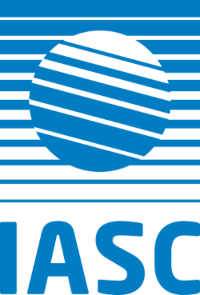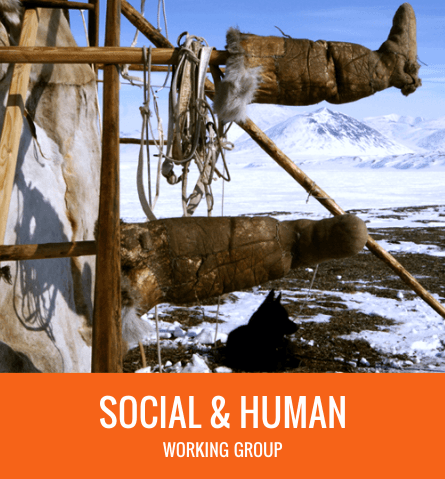 The Multidisciplinary drifting Observatory for the Study of Arctic Climate (MOSAiC) is the first year-round expedition into the central Arctic exploring the coupled Arctic climate system. The project with a total budget exceeding € 150 Million has been designed by an international consortium of leading polar research institutions, under the umbrella of the International Arctic Science Committee (IASC) and led by the Alfred Wegener Institute, Helmholtz Centre for Polar and Marine Research (AWI), Arctic and Antarctic Research Institute (AARI) and the University of Colorado, Cooperative Institute for Research in Environmental Sciences (CIRES).
The Multidisciplinary drifting Observatory for the Study of Arctic Climate (MOSAiC) is the first year-round expedition into the central Arctic exploring the coupled Arctic climate system. The project with a total budget exceeding € 150 Million has been designed by an international consortium of leading polar research institutions, under the umbrella of the International Arctic Science Committee (IASC) and led by the Alfred Wegener Institute, Helmholtz Centre for Polar and Marine Research (AWI), Arctic and Antarctic Research Institute (AARI) and the University of Colorado, Cooperative Institute for Research in Environmental Sciences (CIRES).
After more than a year in the Central Arctic on 12 October, the research icebreaker Polarstern returned to her homeport in Bremerhaven. Accompanied by a ‘welcome committee’ of ships that came to greet, the ship entered the North Lock with the morning high tide, at ca. 9:00 am. At port, Expedition Leader Markus Rex, Captain Thomas Wunderlich and the entire team from the final leg of the expedition were welcomed by e.g. Federal Minister of Research Anja Karliczek and the Director of the Alfred Wegener Institute, Antje Boetius. The event marked the end of a record-breaking expedition: never before had an icebreaker been near the North Pole in winter, and never before could international researchers comprehensively gather such urgently needed climate data in the region of the world hardest hit by climate change. Drifting with the ice, they endured the extreme cold, Arctic storms, a constantly changing floe – and the challenges posed by the coronavirus pandemic.
On 20 September 2019 Polarstern departed from the Norwegian port of Tromsø, bound for the Central Arctic, the epicentre of climate change. Once there, the ship allowed itself to become trapped in the ice, and began a one-year-long drift across the North Pole, completely at the mercy of natural forces – the route and speed were solely determined by the ice drift, powered by wind and currents. Over the five legs of the expedition, a total of 442 researchers, Polarstern crew members, young investigators, teachers and members of the press took part. Seven ships, several aircrafts and more than 80 institutions from 20 countries were involved. The researchers, who hailed from 37 countries, had a common goal: to investigate complex interactions in the climate system between the atmosphere, ice and ocean, as well as life in the Central Arctic, so as to better represent them in climate models. Now they have returned home with a wealth of impressions from the rapidly transforming Arctic, and with an unparalleled treasure trove of data, which an entire generation of climate researchers will focus on analysing.
Even when, due to the coronavirus pandemic, virtually every other expedition around the globe was cancelled, thanks to the broad support of the international scientific community and to the tireless efforts of the entire team, MOSAiC was able to continue. In the early summer, Polarstern had to briefly leave her floe and several autonomous stations for a personnel transfer. Four weeks later, a new team commenced fieldwork on the ice, continuing their efforts right up to the last day, when the floe (as predicted) reached the ice edge to the east of Greenland, began breaking up under the influence of the waves, and completed its typical lifecycle. To explore the last piece of the puzzle in the sea ice’s annual cycle – the formation of new ice at summer’s end – the expedition then headed farther north, crossed the North Pole, and moored to a second floe in its vicinity.
As such, despite all obstacles, the MOSAiC expedition achieved its goal: to monitor the epicentre of climate change more precisely than ever before, and over the span of an entire year – and by doing so, to take a crucial step forward in our understanding of the Earth’s climate system and how it is changing. The total cost of the expedition was ca. 150 million euros, with roughly two-thirds being contributed by Germany.
Website: https://mosaic-expedition.org/
Contacts:
Markus Rex, MOSAiC coordinator
Anja Sommerfeld, MOSAiC manager
Annette Rinke, MOSAiC modeling co-coordination and Vice-Chair IASC AWG
Article from the IASC Bulletin 2021.
The scientific core elements of IASC are its five Working Groups (WGs). The main function of the WGs is to encourage and support science-led international programs by offering opportunities for planning and coordination, and by facilitating communication and access to facilities. Each WG is composed of up to two scientists from each IASC member country, appointed by the national adhering bodies. The members are experts in their field, with an international reputation, and from different scientific disciplines so that the full range of Arctic research is represented in the WGs.
Cross-Cutting Activities
Though the WGs are disciplinary, they also address cross-cutting science questions by initiating activities which involve at least two WGs. The objective of this WG-spanning program is to promote system-scale activities within IASC and to encourage the WGs to explore interdisciplinary activities, in particular across the natural and social sciences.
Subcategories
Call for Proposals
The International Arctic Science Committee (IASC) is now accepting proposals for consideration for IASC funding in 2026 until 5 January 2026 at 13:00 GMT.
The funding is provided by the five IASC Working Groups (WGs) (Atmosphere, Cryosphere, Marine, Social & Human, Terrestrial. It is aimed at encouraging and supporting science-led international programmes by offering opportunities for planning and coordination, and by facilitating communication and access to facilities.
Proposals can be submitted for:
- Cross-cutting Projects (relevant for two or more IASC Working Groups); or
- WG-specific Projects (relevant for only one IASC Working Group)
Cross-Cutting projects encourage the IASC Working Groups (WGs) to explore activities that straddle disciplinary lines. They are funded by at least two of the five IASC WGs. IASC wishes to promote cross-discipline thematic activities and encourage interaction between the WGs, in particular between natural and social sciences WGs.
More information on the scientific priorities of each IASC WG and the IASC Strategic Plan can be found here:
Each IASC Working Group (WG) supports activities that are solely relevant to their scientific priorities by offering funding for WG-specific projects (relevant for only one IASC WG).
More information on the scientific priorities of each IASC WG and the IASC Strategic Plan can be found here:
Requirements
- Applicants are not required to be members of the IASC Working Groups.
- All proposals must be discussed with the relevant IASC WG leadership/membership before submission. Applicants are responsible for contacting the WGs as early as possible in the development phase of the proposal.
- Applications are also welcomed from early career researchers (ECRs). ECRs are strongly encouraged to contact WG leaders/members in the early design phases for potential input or collaboration, and to ensure project alignment with IASC and WG priorities.
- All funded activities must follow the IASC requirements for IASC funded projects.
- Project activities can start the earliest in April 2026 and must be completed within 12 months.
- Projects are encouraged to use the annual Arctic Science Summit Week (ASSW) organised by IASC as a venue for their workshops. The ASSW 2027 will be from 12 - 20 April 2027 in Hakodate, Japan.
Note
- IASC only funds science-led international projects that offer opportunities for planning and coordination, or facilitate communication and access to facilities.
IASC does NOT fund individual research projects or fieldwork.
Evaluation criteria for all proposals:
- Does the activity have scientific merit?
- Does the proposal address and fit within the research priorities identified within the IASC Strategic Plan and the Work Plans of the relevant IASC Working Groups?
- How does the activity intend to promote the involvement of early career scientists not only in the implementation but also the planning of the activity?
- How does the planned activity address Indigenous engagement and collaboration?
- Does the planned activity have an achievable strategy to minimise its carbon footprint?
- Does the project have a good strategy for its planned outcomes and impact of the proposed activity (e.g. deliverables / dissemination strategy / broader impact)?
- Does the activity have support or endorsement from organizations other than IASC?
- If the project requests travel support for participants to attend an event (e.g. workshop, summer school, conference): How well does the proposal describe the selection process / criteria of the recipients of this travel funding?
Additional Evaluation Criterion for Cross-Cutting Proposals:
- How does the activity promote interdisciplinarity and the meaningful involvement of more than one discipline / WG in both its planning and implementation phases?
All lead applicants will be required to present their proposal to the IASC WG members during a webinar organised in the second half of January 2026, and answer questions the WG members might have during the review of the proposals about the proposed projects. The IASC Secretariat will be in touch with all lead applicants after the submission deadline of the proposals to arrange the exact date of this webinar. The webinar will be recorded and the recording made available to all WG members during the proposal review.
WG members will also be invited to ask questions to the lead applicants after this webinar while they are in the process of reviewing the proposals.
Review: The IASC WGs members will review all submitted proposals. A decision on which proposals will receive funding, will be made by the IASC Working Groups during their meetings at the Arctic Science Summit Week 2026 in Aarhus, Denmark, from 25 March - 1 April 2026
Announcements of Decisions: Applicants will be informed by the IASC Secretariat about the final result of their application by early to mid April 2026.






